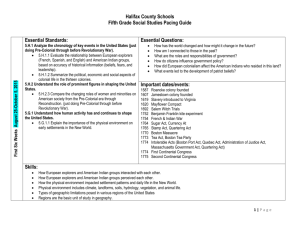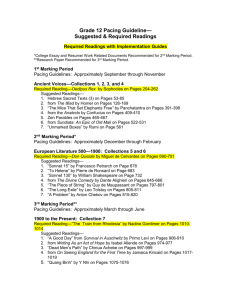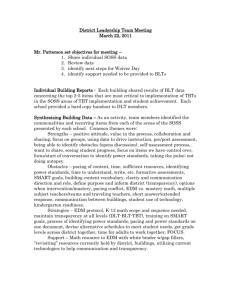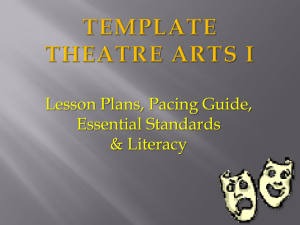Social Studies Grade Pacing Guide 2013-2014
advertisement
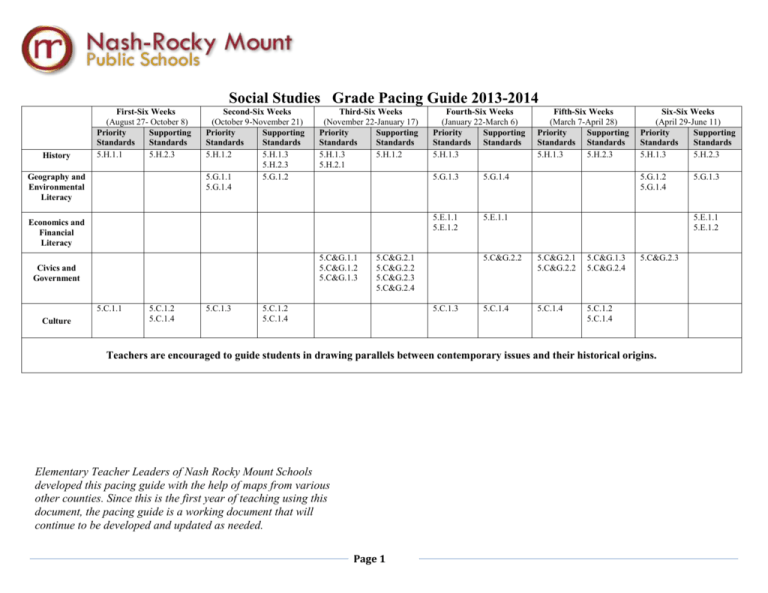
Social Studies Grade Pacing Guide 2013-2014 History First-Six Weeks (August 27- October 8) Priority Supporting Standards Standards 5.H.1.1 5.H.2.3 Geography and Environmental Literacy Second-Six Weeks (October 9-November 21) Priority Supporting Standards Standards 5.H.1.2 5.H.1.3 5.H.2.3 5.G.1.1 5.G.1.2 5.G.1.4 Third-Six Weeks (November 22-January 17) Priority Supporting Standards Standards 5.H.1.3 5.H.1.2 5.H.2.1 Economics and Financial Literacy 5.C&G.1.1 5.C&G.1.2 5.C&G.1.3 Civics and Government 5.C.1.1 Culture 5.C.1.2 5.C.1.4 5.C.1.3 Fourth-Six Weeks (January 22-March 6) Priority Supporting Standards Standards 5.H.1.3 5.G.1.3 5.G.1.4 5.E.1.1 5.E.1.2 5.E.1.1 5.C&G.2.1 5.C&G.2.2 5.C&G.2.3 5.C&G.2.4 5.C.1.2 5.C.1.4 5.C.1.3 Fifth-Six Weeks (March 7-April 28) Priority Supporting Standards Standards 5.H.1.3 5.H.2.3 Six-Six Weeks (April 29-June 11) Priority Supporting Standards Standards 5.H.1.3 5.H.2.3 5.G.1.2 5.G.1.4 5.E.1.1 5.E.1.2 5.C&G.2.2 5.C&G.2.1 5.C&G.2.2 5.C&G.1.3 5.C&G.2.4 5.C.1.4 5.C.1.4 5.C.1.2 5.C.1.4 5.C&G.2.3 Teachers are encouraged to guide students in drawing parallels between contemporary issues and their historical origins. Elementary Teacher Leaders of Nash Rocky Mount Schools developed this pacing guide with the help of maps from various other counties. Since this is the first year of teaching using this document, the pacing guide is a working document that will continue to be developed and updated as needed. Page 1 5.G.1.3 Social Studies Grade Pacing Guide 2013-2014 throughout the year. Priority Standards North Carolina Essential Standards Supporting Standards 5. H.1.1 Evaluate the relationships between European explorers (French, English and Spanish) and American Indian groups, based on the accuracy of historical information (beliefs, fears and leadership). 5. C.1.4 Understand how cultural narratives (legends, songs, ballads, games, folk tales and art forms) reflect the lifestyles, beliefs and struggles of diverse ethnic groups. 5. C.1.1 Analyze the change in leadership, cultures, and everyday life of American Indian groups before and after European exploration 5. C.1.2 Exemplify how the interactions of various groups have resulted in borrowing and sharing of traditions and technology. 1st 6 Weeks Conceptual Lenses Continuity Change Exploration 5. H.2.3 Compare the changing roles of women and minorities on American society from Pre-Colonial through reconstruction Unpacking: What does this standard mean? What will a student know, understand, and be able to do? The positive and negative effects of the relationships between European explorers and American Indian groups. Internal and external forces that affected change (leadership, culture, everyday life) to Native Americans during early European exploration. Early exploration and settlement patterns. The cultural, political, and social impact of diverse cultural groups on the development of a new nation. Concepts (What students need to know) Skills (What students must be able to do) Page 2 RBT Level Social Studies Grade Pacing Guide 2013-2014 How European explorers and American Indian groups interacted with each other and perceived each other. Key American Indian groups before and after European exploration. Aspects of culture and everyday life among American Indian groups Analyze multiple sources from varying points of view. Evaluate relationships between American Indians and European Explorers o Beliefs o Fears o Leadership Analyze American Indian groups before and after European explorers. o Leadership o Culture Everyday life Essential Vocabulary Content Vocabulary Exploration Perception Culture League Historian confederation Algonquian Iroquoian longhouses barter Aleut Inuit culture diversity civilization navigation expedition missionary astrolabe chronometer compass cartographers Page 3 Understanding Analyzing Evaluating Social Studies Grade Pacing Guide 2013-2014 ancestors Page 4 Social Studies Grade Pacing Guide 2013-2014 Resources Suggested Product Tasks Create a set of GPS like directions for the Trail of Tears and be prepared to share. Include illustrations if needed. Debate whether or not the Europeans should have forced the Native Americans to move. Create a travel guide to use during the early American West. Page 5 Suggested Thinking Maps Mulit-Flow Map On everyday life of American Indian groups before and after European exploration. Tree Map On the key American groups of Indians o Algonquian o Iroquois o Plains o Pueblos o Navajo o Northwest coast Social Studies Grade Pacing Guide 2013-2014 Priority Standards 5. H.1.2 Summarize the political, economic and social aspects of colonial life in the thirteen colonies. 5. G.1.1 Explain the impact of the physical environment on early settlements in the New World. 5. G.1.4 Exemplify migration within or immigration to the United States in order to identify push and pull factors (why people left/why people come). 5. C.1.3 Exemplify how the movement of goods, ideas and various cultural groups influenced the development of regions in the United States. North Carolina Essential Standards Supporting Standards 5. H.1.3 Analyze the impact of major conflicts, battles and wars on the development of our nation through reconstruction. 5. H.2.3 Compare the changing roles of women and minorities on American society from Pre-Colonial through reconstruction. 5. G.1.2 Explain the positive and negative effects of human activity on the physical environment of the United States, past and present. 5. C.1.2 Exemplify how the interactions of various groups have resulted in borrowing and sharing of traditions and technology. 5. C.1.4 Understand how cultural narratives (legends, songs, ballads, games folk talks and art forms) reflect the lifestyles, beliefs and struggles of diverse ethnic groups. Page 6 2nd 6 Weeks Conceptual Lenses Migration Settlement Patterns Social Studies Grade Pacing Guide 2013-2014 Unpacking: What does this standard mean? What will a student know, understand, and be able to do? Push/Pull Factors. Political, social, and cultural characteristics of the colonies. The effect of physical environment on settlement patterns. The role of cultural groups in the development of regions. Concepts (What students need to know) Daily life in the colonies varied based upon the cultural background of the inhabitants. Political and economic structures varied among the colonies. The physical environment impacted settlement patterns and daily life in the New World. Migration and settlement patterns are affected by push/pull factors. Regions (formal and informal) are defined by unifying characteristics (human, physical,economic). Skills (What students must be able to do) Summarize political, economic, and social aspects of thirteen colonies. Explain impact of physical environment Exemplify migration and immigration to the colonies. Identify push/pull factors Exemplify the role cultural groups played in regional development. Page 7 RBT Level Understanding Analyzing Social Studies Grade Pacing Guide 2013-2014 colony slavery borderlands presidio mission cash crop dissent triangular trade routes Middle Passage charter indentured servant religious toleration plantation naval stores Text Resources Other Resources Unit 2 Lesson 4 & 5 of Harcourt SS Text www.eharcourtschool.com Content Vocabulary Suggested Thinking Maps Page 8 Social Studies Grade Pacing Guide 2013-2014 Page 9 Social Studies Grade Pacing Guide 2013-2014 Priority Standards 5. H.1.3 Analyze the impact of major conflicts, battles and wars on the development of our nation through reconstruction. 5. H.2.1 Summarize the contributions of the "Founding Fathers" in the development of our country. 5. C&G.1.1 Explain how ideas of various governments influenced the development of the United States government (Roman, Greek, Iroquois, European, and British). 5. C&G.1.2 Summarize the organizational structures and powers of the United States government (legislative, judicial, and executive branches of government). 5. C&G.1.3 Analyze historical documents that shaped the foundation of the United States government. North Carolina Essential Standards Supporting Standards 5. H.1.2 Summarize the political, economic, and social aspects of colonial life in the thirteen colonies. 5. C&G.2.1 Understand the values and principles of a democratic republic. 5. C&G.2.2 Analyze the rights and responsibilities of the United States citizens in relation to the concept of "common good" according to the United States Constitution (Bill of Rights). 5. C&G.2.3 Exemplify ways in which the rights, responsibilities and privileges of citizens are protected under the United States Constitution. 5. C&G.2.4 Explain why civic participation is important in the United States. Page 10 3rd 6 Weeks Conceptual Lenses National Identity Government Systems Conflict Social Studies Grade Pacing Guide 2013-2014 Unpacking: What does this standard mean? What will a student know, understand, and be able to do? Influence of conflict on the political, social, and economic development of the United States. Founding Fathers. Founding documents. How self-government in other parts of the world influenced the development of the United States government. Branches of government. United States government was structured to meet the needs of the people. Concepts (What students need to know) Social, political, and economic issues that were a source of conflict during colonial time period. The significance of the American Revolution. The role of specific significant battles in the American Revolution. Contributions made by the “Founding Fathers”. How ideas about self government influenced the development of the United States. Organizational structures of the branches of the United States government. Skills (What students must be able to do) RBT Level Analyze major conflicts, battles, and wars. Summarize role of “Founding Fathers”. Explain how the United States system of government was developed. Understand how the ideas of various governments contributed to the development of the United States government. Summarize structures and powers of United States government Judicial Legislative Executive Essential Vocabulary Content Vocabulary Self-government Founding Fathers Historical Documents Conflict Branches of Government Revolution Conflicts Battles Nation Reconstruction Summarize Contribution Page 11 Understanding Analyzing Social Studies Grade Pacing Guide 2013-2014 Founding Fathers Resources Suggested Product Tasks http://williamslibrary.wikispaces.com/5th+grade+Founding+Fathers Suggested Thinking Maps Multi-Flow Map The Magna Carta: http://www.uintahbasintah.org/usdocuments/doc62.pdf English Bill of Rights>: http://www.uintahbasintah.org/usdocuments/doc63.pdf The Bill of Rights: http://www.uintahbasintah.org/usdocuments/doc61.pdf Unit 5 in Harcourt Horizons United States History, Canada. Mexico, and Central America http://www.clrn.org/weblinks/browse.cfm?id=94 US History Timeline App Page 12 Social Studies Grade Pacing Guide 2013-2014 North Carolina Essential Standards Priority Standards Supporting Standards 5. G.1.3 Exemplify how technological advances 5. E.1.1 Summarize the role of international trade between (communication, transportation and agriculture) have allowed the United States and other countries through people to overcome geographic limitations. Reconstruction. 5. E.1.2 Explain the impact of production, specialization, technology and division of labor on the economic growth of the United States. 5. H.1.3 Analyze the impact of major conflicts, battles and wars on the development of our nation through reconstruction. 5. C.1.3 Explain how the movement of goods, ideas and various cultural groups influenced the development of regions in the United States. 5. E.1.1 Summarize the role of international trade between the United States and other countries through Reconstruction. 5. C&G.2.2 Analyze the rights and responsibilities of the United States citizens in relation to the concept of "common good" according to the United States Constitution (Bill of Rights). 4th 6 Weeks Conceptual Lenses Technology and Innovation Human Environment Interactions Movement 5. C.1.4 Understand how cultural narratives (legends, songs, ballads, games folk talks and art forms) reflect the lifestyles, beliefs and struggles of diverse ethnic groups. 5. G.1.4 Exemplify migration within or immigration to the United States in order to identify push and pull factors (why people left/why people come). Unpacking: What does this standard mean? What will a student know, understand, and be able to do? Economic growth in the United States as a result of production, specialization, technology, and division of labor. Technological innovations that helped to overcome geographic limitations. How the movement of goods, ideas, and people affected regional development. Economic, political, and social impact of the War of 1812 ,the Mexican War, and the Missouri Compromise. Concepts (What students need to know) Skills (What students must be able to do) Page 13 RBT Level Social Studies Grade Pacing Guide 2013-2014 How technological advances in communication, agriculture, and transportation allowed people to overcome geographic limitations. Key economic terms such as production, specialization, division of labor, economic growth. The impact of social, political, and economic issues that were a source of conflict. Geographic regions are defined by unifying characteristics (physical, human, economic). The role of supply and demand in a market economy Major imports and exports in the United States. Exemplify technological advances that allowed people to overcome geographic limitations during the time period. Explain economic growth during the time period. Analyze economic, political, and social impact of War of1812 and Mexican War. Explain regional development. Summarize international trade. Essential Vocabulary Production Specialization Division of Labor Economic Growth Technology Economy Free enterprise Entrepreneur Goods Trade Settlement Sectionalism Acquittal homesteader Resources Suggested Product Tasks Page 14 Understanding Analyzing Content Vocabulary transportation agriculture transcontinental railroad human, capital, and natural resource Production Specialization Labor Suggested Thinking Maps Social Studies Grade Pacing Guide 2013-2014 Harcourt Horizons: United States History…. Harcourt Social Studies: The United States…. http://www.radford.edu/~sbisset/civilwar.htm http://pinzler.com/ushistory/timeline6.html https://sites.google.com/site/stewart45resourcesforss/fifthgrade/economics-strand Paideia Seminar Plan strategies to solve the problems people faced on the Oregon Trail Use toontastic or use self made comic books to create and explain a non linguistic representation so that limited English speaking students will understand the causes, important events, an effects of the War of http://www.takechargeamerica.org/financial-educationresources/educator-resources/fifth-grade-lesson-plans/ Page 15 Multi - flow map Cause and Effect map of The War of 1812 Flow map for movement of goods Social Studies Grade Pacing Guide 2013-2014 North Carolina Essential Standards Priority Standards Supporting Standards 5. H.1.3 Analyze the impact of major conflicts, battles 5. H.2.3 Compare the changing roles of women and minorities on and wars on the development of our nation through American society from Pre-Colonial through reconstruction. reconstruction. 5. C&G.1.3 Analyze historical documents that shaped the 5. C&G.2.1 Understand the values and principles of a foundation of the United States government. democratic republic. 5. C&G.2.4 Explain why civic participation is important in the United 5. C&G.2.2 Analyze the rights and responsibilities of States. the United States citizens in relation to the concept of "common good" according to the United States 5. C.1.2 Exemplify how the interactions of various groups have Constitution (Bill of Rights). resulted in borrowing and sharing of traditions and technology. 5. C.1.4 Understand how cultural narratives (legends, songs, ballads, games folk talks and art forms) reflect the lifestyles, beliefs and struggles of diverse ethnic groups. 5th 6 Weeks Conceptual Lenses Conflict Power and Authority Common Good Rights and Responsibilities 5. C.1.4 Understand how cultural narratives (legends, songs, ballads, games folk talks and art forms) reflect the lifestyles, beliefs and struggles of diverse ethnic groups. Unpacking: What does this standard mean? What will a student know, understand, and be able to do? The transformation that took place in the United States during the time of the Civil War. How the values and principles of a democratic society are exhibited during times of conflict and war. The rights and responsibilities of United States citizens in relation to the concept of “Common Good” established by the US Constitution (Bill of Rights). How diverse ethnic groups use cultural narratives to reveal their values, lifestyles, beliefs, and struggles. Concepts (What students need to know) Economic, social and political issues that were a Skills (What students must be able to do) Analyze the impact of the Civil War on the United States. Page 16 RBT Level Understanding Social Studies Grade Pacing Guide 2013-2014 source of conflict during the Civil War time period and the impact on the development of the United States. The exclusion of certain groups from membership in a democratic society leads to conflict. The rights and responsibilities of citizens granted by the United States Constitution as they relate to the concept of the “common good”. The historical background of cultural narratives in order to understand their context. Republic Principles Secede Essential Vocabulary Understand democratic values and principles. Analyze rights and responsibilities of citizens. Understand cultural narratives as they relate to and reflect. o Lifestyle o Beliefs o Struggles Democracy Election Campaign Democratic Laissez-faire Rights Responsibilities Laws Amendment Due process Common good Analyze Bill of Rights Constitution Citizen Civics Civic participation Page 17 Content Vocabulary Analyzing Social Studies Grade Pacing Guide 2013-2014 Text Resources Other Resources Suggested Thinking Maps http://www.ccboe.com/teachers/sfulcher/roots.democracy.htm Multi-Flow Map Harcourt Horizons: United States http://rileytipp.wikispaces.com/7.+Student+page History…. Harcourt Social Studies: The United States… http://www.historyforkids.org/learn/northamerica/after1500/government/billofrights.htm Constitution Ipad App http://www.usconstitution.net/constkids4.html http://betterlesson.com/directory/fifth_grade/government_and_civics http://learningtogive.org/papers/paper11.html Priority Standards 5. H.1.3 Analyze the impact of major conflicts, battles and wars on the development of our nation through reconstruction. North Carolina Essential Standards Supporting Standards 5. H.2.3 Compare the changing roles of women and minorities on American society from PreColonial through reconstruction. 5. G.1.2 Explain the positive and negative effects of human activity on the physical environment of the United States, past and present. 5. G.1.3 Exemplify how technological advances (communication, transportation and agriculture) have allowed people to overcome geographic limitations. 5. G.1.4 Exemplify migration within or 5. E.1.1 Summarize the role of Page 18 6th 6 Weeks Conceptual Lenses Migration and Settlement Democracy Human Activity Social Studies Grade Pacing Guide 2013-2014 immigration to the United States in order to identify push and pull factors (why people left/why people come). 5. C&G.2.3 Exemplify ways in which the rights, responsibilities and privileges of citizens are protected under the United States Constitution. international trade between the United States and other countries through Reconstruction. 5. E.1.2 Explain the impact of production, specialization, technology and division of labor on the economic growth of the United States. Unpacking: What does this standard mean? What will a student know, understand, and be able to do? The impact of the Civil War on the political, social, and economic development of the United States during Reconstruction. The ways human activity modified, improved, and exploited the physical environment. Migration and settlement patterns of freed slaves during Reconstruction. The role of the United States Constitution in protecting the rights, responsibilities, and privileges of citizens. Concepts (What students need to know) Impact of Reconstruction on the economic, social, and political development of the United States. The negative effects of human activity on the physical environment of the United States as a result of the Civil War. The push/pull factors that influenced settlement patterns of freed slaves after the Civil War. Examples of how the United Sates Constitution identifies the rights, responsibilities, and privileges of United States Skills (What students must be able to do) Analyze political, social, and economic impact of Reconstruction. Explain negative effects of human activity on the physical environment because of the Civil War. Exemplify settlement patterns of freed slaves. Exemplify rights, responsibilities, and privileges protected under the Constitution. Page 19 RBT Level Understanding Analyzing Social Studies Grade Pacing Guide 2013-2014 citizens. Essential Vocabulary Content Vocabulary Reconstruction Freedmen Carpetbaggers Sharecropper Amendment Resources Suggested Product Tasks Harcourt Horizons: United States History…. Harcourt Social Studies: The United States…. Page 20 Suggested Thinking Maps

